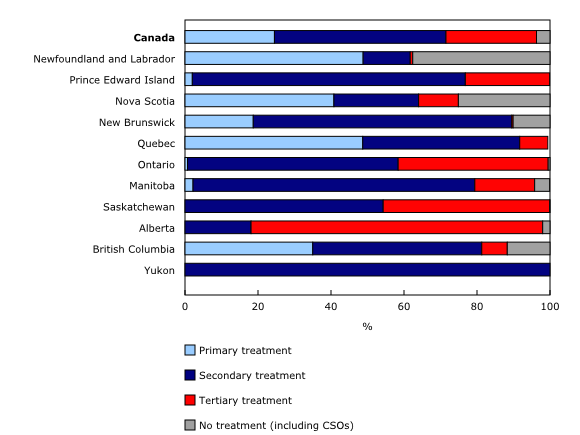Municipal wastewater systems in Canada, 2018 to 2020
Released: 2023-05-11
Canadian municipalities reported a 3.9% decrease in wastewater volumes in 2020 to 5 793 million cubic metres, following a 4.7% increase in wastewater volumes in 2019. The year 2020 marks the third decline of wastewater volumes since the start of the series in 2013. Similar to previous years, 3.7% of wastewater, including combined sewer overflows, was untreated prior to being discharged in 2020.
Wastewater (sewage) volumes
In 2020, just under 5 800 million cubic metres of sewage flowed through municipal wastewater systems in Canada. These systems receive sewage discharged from residential, industrial, commercial and institutional sources. The volume also includes storm water that enters the collection pipes which convey the wastewater to treatment plants before discharge to surface water sources such as lakes, rivers or oceans.
From a provincial standpoint, 7 of 10 provinces recorded lower volumes of sewage processed by collection and treatment systems in 2020, with Ontario (-5.3%) and Quebec (-5.1%) contributing the most to the decline. Combined, volumes of processed wastewater in Quebec and Ontario accounted for around 71% of Canada's total.
An additional 117 million cubic metres was reported to be discharged from combined sewer overflows in 2020. Combined sewer systems convey both storm water and sewage to wastewater treatment plants. Many of these systems have multiple overflow structures that may discharge untreated sewage mixed with storm water into receiving waters when full capacity has been reached during intense runoff.
Nearly all wastewater in Canada is treated prior to its discharge
In 2020, 1 449 million cubic metres of wastewater were discharged from primary treatment systems, which removes a portion of suspended solids and organic matter by physical and/or chemical processes.
Secondary treatment systems, which remove biodegradable organic matter and suspended solids using biological treatment processes and secondary settlement, processed 2 776 million cubic metres of wastewater.
Tertiary systems, which further remove residual suspended solids, nutrients and other contaminants using various physical, chemical or biological processes, released 1 466 million cubic metres of wastewater.
Systems that provide no treatment discharged 102 million cubic metres of wastewater back into the environment in 2020.
The total volume of untreated wastewater from systems that provided no treatment and combined sewer overflow that was discharged amounted to 219 million cubic metres in 2020. This is equivalent to about 3.7% of all wastewater collected and discharged by municipal wastewater systems in Canada.
31.5 million people served by municipal wastewater systems in 2020
In 2020, just under 31.5 million people were served by municipal wastewater systems that have daily flows that process 100 cubic metres or more per day. Primary treatment systems served almost 5 million people, secondary treatment systems processed wastewater for 15.6 million people, and tertiary treatment systems served 10.3 million people. Over 672,000 people discharged their wastewater into systems that provide no treatment. The remaining 5.0 million people either had their own on-site wastewater system or were served either by other systems with daily flows less than 100 cubic metres per day or by other facilities outside the scope of this statistical activity.
Note to readers
As of 2018, no combined sewer overflow volumes from Quebec municipalities are available, thus estimates for combined sewer overflows and total volumes of untreated wastewater do not include municipal wastewater systems in the province of Quebec.
The target population is composed of municipal wastewater systems in Canada with a daily flow of 100 cubic metres or more per day, representing a population of approximately 2,000 systems. These estimates exclude systems that service First Nations reserves, government institutions, commercial and industrial establishments, and provincial parks.
Contact information
For more information, or to enquire about the concepts, methods or data quality of this release, contact us (toll-free 1-800-263-1136; 514-283-8300; infostats@statcan.gc.ca) or Media Relations (statcan.mediahotline-ligneinfomedias.statcan@statcan.gc.ca).
- Date modified:

